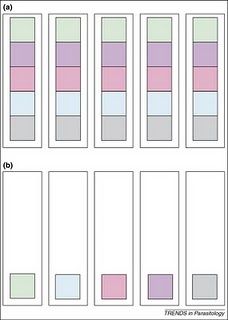When can we stop sampling and have a beer?
 Wednesday, March 31, 2010 at 10:00AM
Wednesday, March 31, 2010 at 10:00AM Tom and I wrote our paper after many nights in the field spent dissecting coral reef fishes to recover new species of parasitic worms - a time consuming and sometimes tedious process (sometimes thrilling too, depending on what you do or don't find). We were often motivated by another far more important factor too - when can we stop all this bloody sampling so that we can go and have a beer on the beach?!? Species accumulation curves therefore have a very practical aspect to them - they tell you when its OK to stop sampling because you've either sampled all the available species, OR, you've sampled enough to extrapolate a good estimate of how many species there might be.
Back to Eric Seabloom. He and his colleagues wrote a paper about the diversity of aphid-borne viruses infecting grasses of the US Pacific northwest and Canada. While the environment that they sampled was about as far away as its possible to be from the coral reefs that Tom and I looked at, the patterns of saturated and unsaturated communities they observed were the same. I get a huge buzz out of that, and that out of the morass of published science out there, Dr. Seabloom found a scientific kindred spirit who had had the same thoughts and ideas about nature, however different the specific areas of study. While Tom and I sipped beers on the beach and watched the sunset over the reef, I wonder if Eric and his colleagues blew the froth off a few while they watched the wind waves spread across the grasslands. There's something so unifying about science; it can give you common ground with someone you never would have otherwise known, and that's just one reason why I love it so much.
*The tendency for a continuing application of effort or skill toward a particular project or goal to decline in effectiveness after a certain level of result has been achieved. Answers.com
DOVE, A., & CRIBB, T. (2006). Species accumulation curves and their applications in parasite ecology Trends in Parasitology, 22 (12), 568-574 DOI: 10.1016/j.pt.2006.09.008
ERIC W. SEABLOOM, ELIZABETH T. BORER, CHARLES E. MITCHELL, & ALISON G. POWER (2010). Viral diversity and prevalence gradients in North American Pacific Coast grasslands Ecology, 91 (3), 721-732 (doi:10.1890/08-2170.1)
 3 Comments |
3 Comments |  Email Article | tagged
Email Article | tagged  coral reef,
coral reef,  diversity,
diversity,  ecology,
ecology,  fish,
fish,  parasites,
parasites,  species accumulation curves
species accumulation curves 



Reader Comments (3)
Nice piece, and great title. The next time I am teaching students how to generate species accumulation curves and perform rarefaction, I am setting it up with "when can we have a beer" as the problem we are really solving.
Because it *is* the problem we are really solving.